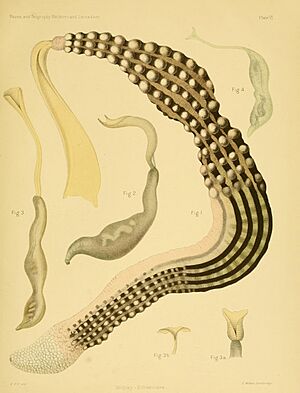Clive Forster-Cooper facts for kids
Quick facts for kids
Clive Forster-Cooper
|
|
|---|---|
| Born | 3 April 1880 |
| Died | 23 August 1947 (aged 67) |
| Nationality | British |
| Alma mater | Trinity College, Cambridge |
| Scientific career | |
| Fields | Palaeontology |
Sir Clive Forster-Cooper (born April 3, 1880 – died August 23, 1947) was an English palaeontologist. Palaeontologists are scientists who study fossils to learn about ancient life. Forster-Cooper was very important because he was the first to describe Paraceratherium. This animal is also known as Indricotherium or Baluchitherium. It was the largest land mammal ever known!
Forster-Cooper also led two big museums. He was the director of the Cambridge University Museum of Zoology. Later, he became the director of the famous Natural History Museum in London.
Contents
Early Life and Education
Clive Forster-Cooper was born in Hampstead, London, on April 3, 1880. He was the only son in his family. His grandfather, Miles Miley, loved nature and plants. He encouraged young Clive to be interested in natural history too.
Clive went to good schools like Summer Fields School and Rugby School. In 1897, he started studying at Trinity College, Cambridge. He earned his first degree in 1901 and a master's degree in 1904.
Exploring the World and Ancient Animals
In 1900, Forster-Cooper went on an exciting trip. He traveled with another scientist, John Stanley Gardiner, to the Maldives and Lakshadweep Islands. They collected many samples and studied how coral reefs are formed.
From 1902 to 1903, he worked for a science group studying the North Seas Fisheries. He sailed around the Indian Ocean. During this time, he collected many different animals and plants from places like the Seychelles.
In 1905, he joined another expedition to the Indian Ocean. When he returned to Cambridge in 1906, he continued to study the amazing collections he had gathered.
In 1907, something important happened. He met Dr. C. W. Andrews, an expert on the history of elephants, at the British Museum of Natural History. This meeting made Forster-Cooper very interested in fossil mammals.
Because of this new interest, he joined Dr. Andrews on a fossil-collecting trip to Fayum in 1907. His passion for ancient animals grew. He even went to the American Museum of Natural History in New York. There, he worked with famous scientists like H. F. Osborn. He spent a year studying fossil mammals and even joined a fossil-hunting trip in Wyoming.
When he came back to Cambridge University, he organized his own expedition. He wanted to find large fossil mammals, especially the giant rhinoceros called Baluchitherium (now known as Paraceratherium). He found these amazing fossils in Baluchistan.
Leading Museums
Forster-Cooper became the director of the Cambridge University Museum of Zoology in 1914. He worked there until 1938. During the First World War, he helped with research on human animal parasites. He studied how a medicine called quinine affected malaria.
After the war, he returned to Cambridge University. He held several important jobs in the Zoological Laboratory. He taught students and became a reader in Vertebrata, which means he was an expert in animals with backbones. He was also a fellow at Trinity Hall. His old lecture notes are still kept in the museum's archives!
In 1938, Forster-Cooper was chosen to be the director of the Natural History Museum in London. This was a very important job. Many of the museum's collections were stored in glass jars with flammable alcohol. During the Second World War, the museum was bombed several times. Forster-Cooper made sure that many of the most important parts of the collection were moved to a safer storage place in Tring.
He was recognized for his great work. In 1936, he was elected to the Royal Society, a very respected group of scientists. In 1946, he was made a knight, which means he was given the title "Sir." He was also a member of science groups in New York and America.
Sir Clive Forster-Cooper passed away on August 23, 1947.
Family Life
On July 25, 1912, Clive Forster-Cooper married Rosalie Tunstall-Smith in London. They had two sons and one daughter. His daughter helped during World War II by spotting bombs in London. She later married an American soldier and moved to the United States. Lady Forster-Cooper died in 1965.
Animal Named in His Honor
An animal was named after him! The red-bar anthias, a type of fish, is called Pseudanthias cooperi.


